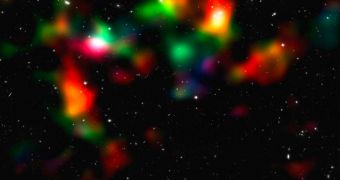Scientists using the NASA Hubble Space Telescope for a new survey said that the idea of cosmic acceleration is indeed valid. They present their latest findings in a new scientific paper, saying that a study of the way galaxies become distorted has offered additional credence to this long-held belief. They say that the investigation also managed to produce what could best be referred to as a 3D map of parts of the Universe, as the telescope tracked galaxies of interest in the sky, experts at the European Space Agency (ESA) write on their official website.
This was without any doubt the most ambitious survey that the Hubble ever conducted, the team behind the work says. The comprehensive analysis of the distorted galaxies was part of the Cosmological Evolution Survey (COSMOS), and it had more than 446,000 targets. The group of astronomers that conducted the investigation was led by Leiden Observatory expert Tim Schrabback. His team managed to capture about 575 images of the same portion of the Universe, using the Hubble Advanced Camera for Surveys (ACS). All of the images were taken from slightly-different angles.
When combined, they create the impression that you are looking at a 3D environment. This image was obtained after more than 1,000 hours of observation, the team says. By adding ground-based measurements to the Hubble datasets, the investigators were able to assign accurate distance assessments to the 194,000+ galaxies in the final photo. “The sheer number of galaxies included in this type of analysis is unprecedented, but more important is the wealth of information we could obtain about the invisible structures in the Universe from this exceptional dataset,” explains Edinburgh University expert Patrick Simon, who was also a member of the study team.
“With more accurate information about the distances to the galaxies, we can measure the distribution of the matter between them and us more accurately,” says of the results Jan Hartlap, another member of the team, who holds an appointment at the University of Bonn. “Before, most of the studies were done in 2D, like taking a chest X-ray. Our study is more like a 3D reconstruction of the skeleton from a CT scan,” concludes Harvard University astronomer William High. Details of the new research will appear in an upcoming issue of the respected scientific journal Astronomy and Astrophysics.

 14 DAY TRIAL //
14 DAY TRIAL //